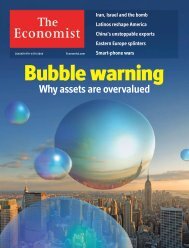Untitled - the ultimate blog
Untitled - the ultimate blog
Untitled - the ultimate blog
Create successful ePaper yourself
Turn your PDF publications into a flip-book with our unique Google optimized e-Paper software.
Thinking space<br />
Ano<strong>the</strong>r way to encourage gifted individuals might be to reform <strong>the</strong> way time on telescopes is allocated.<br />
The IAU’s new president, Robert Williams of <strong>the</strong> Space Telescope Science Institute in Baltimore, Maryland,<br />
is a supporter of this idea. He reckons decisions about who gets what observing time should be made by<br />
<strong>the</strong> directors of observatories, answerable to a governing body, ra<strong>the</strong>r than by groups of <strong>the</strong> great and<br />
good, as tends to happen now.<br />
“High-risk, high-reward projects require hard decisions that are best made by individuals, not<br />
committees,” he says. And he should know. As director of <strong>the</strong> Space Telescope Science Institute he was,<br />
in 1995, allocated ten days on Hubble (pictured above), America’s most famous eye in <strong>the</strong> sky. Instead of<br />
using that time on a project with a preordained objective, he asked, in what might be seen as an act of<br />
ei<strong>the</strong>r modesty or bravura, that <strong>the</strong> telescope be pointed at a typical patch of sky and left <strong>the</strong>re for <strong>the</strong><br />
whole period, to see what it could see.<br />
The result was <strong>the</strong> Hubble Deep Field, a fantastically detailed image of a small region in a constellation<br />
called Ursa Major. The field of view is so narrow that only about 20 stars from <strong>the</strong> Milky Way, <strong>the</strong> galaxy<br />
in which <strong>the</strong> Earth resides, lie within it. What it shows instead is almost 3,000 galaxies, some of which are<br />
<strong>the</strong> most distant (and hence <strong>the</strong> youngest) ever observed. The image demonstrates that <strong>the</strong> universe is,<br />
indeed, uniform over large scales and that <strong>the</strong> Earth occupies a typical region of it. It is unlikely that a<br />
committee would have had <strong>the</strong> guts to allocate so much time to what was a speculative punt.<br />
Yet despite <strong>the</strong> professed desire of some to do so, astronomers cannot turn <strong>the</strong>ir backs on big science. In<br />
particular, to see faint, distant objects at <strong>the</strong> dawn of time, as Dr Williams did with Hubble, you need to<br />
collect a lot of light. That means your telescopes need big mirrors. And big mirrors do not come cheap.<br />
Back on Earth, <strong>the</strong> biggest mirrors in prospect belong to three telescopic<br />
projects that will, by coincidence, all come to fruition in 2018, if <strong>the</strong>ir<br />
backers get <strong>the</strong>ir way. The Giant Magellan Telescope, a joint effort by<br />
America, Australia and South Korea that is to be built in <strong>the</strong> Atacama<br />
Desert in Chile, would have seven mirrors, each 8.4 metres across, giving<br />
an effective diameter of 25 metres. An even larger beast, dubbed <strong>the</strong><br />
Thirty Metre Telescope, for obvious reasons, is a collaboration between<br />
American and Canadian universities. It has been on <strong>the</strong> drawing board<br />
since 1990. Last month its project board announced that, if funding were<br />
forthcoming, it would be built on Mauna Kea in Hawaii.<br />
The third, <strong>the</strong> European Extremely Large Telescope, is <strong>the</strong> suggested<br />
replacement for <strong>the</strong> Overwhelmingly Large Telescope, a proposal rejected<br />
by <strong>the</strong> European Sou<strong>the</strong>rn Observatory three years ago when it discovered<br />
that <strong>the</strong> bill would also be overwhelmingly large. Its mirror would be 42<br />
metres across, and it would probably be built ei<strong>the</strong>r on one of <strong>the</strong> Canary<br />
Islands or in Chile.<br />
Science Photo Library<br />
Galileo moved <strong>the</strong> Earth<br />
Besides <strong>the</strong>se new conventional telescopes, completely novel ways of doing Big Astronomy are likely to<br />
emerge to tempt astronomers back into its clutches. Several projects are already under way to detect<br />
gravitational waves—ripples in <strong>the</strong> fabric of spacetime itself—although none has yet caught its quarry.<br />
Should <strong>the</strong>y, or <strong>the</strong>ir successors, eventually do so, it would open up a new window on <strong>the</strong> universe,<br />
allowing astronomers to study massive objects such as colliding black holes in unprecedented detail.<br />
Astrophysicists have also begun to be able to detect <strong>the</strong> directions from which streams of subatomic<br />
particles called neutrinos arrive, and progress is being made as well on interpreting cosmic rays. Once<br />
<strong>the</strong>se are better understood, astronomers could use <strong>the</strong>m to study <strong>the</strong> universe in <strong>the</strong> way <strong>the</strong>y now use<br />
light and radio waves.<br />
Yet astronomers are still right to want space for <strong>the</strong> small. The two most exciting recent findings—<strong>the</strong><br />
discovery of “dark energy”, which pushes space itself apart, and of planets beyond <strong>the</strong> solar system—were<br />
made using modest equipment. It is <strong>the</strong> very success of <strong>the</strong> small that promotes <strong>the</strong> growth of <strong>the</strong> big.<br />
Copyright © 2009 The Economist Newspaper and The Economist Group. All rights reserved.<br />
-121-








![[ccebbook.cn]The Economist August 1st 2009 - the ultimate blog](https://img.yumpu.com/28183607/1/190x252/ccebbookcnthe-economist-august-1st-2009-the-ultimate-blog.jpg?quality=85)



![[ccebook.cn]The World in 2010](https://img.yumpu.com/12057568/1/190x249/ccebookcnthe-world-in-2010.jpg?quality=85)
![[ccemagz.com]The Economist October 24th 2009 - the ultimate blog](https://img.yumpu.com/5191885/1/190x252/ccemagzcomthe-economist-october-24th-2009-the-ultimate-blog.jpg?quality=85)